|
|
|
Sort Order |
|
|
|
Items / Page
|
|
|
|
|
|
|
| Srl | Item |
| 1 |
ID:
187348


|
|
|
|
|
| Summary/Abstract |
Transfer of technology (TOT) is a contentious issue in the international defence trade. In 2019 it was estimated to form at least 40%, or $123 billion USD, of total international defence trade. Whilst purchasing nations set requirements for TOT within their industrial participation (IP) policies, there is often a mismatch between the scale and type of technology suppliers can offer and the buyer’s technological absorption capability (TAC). This persistent tension between ambition and reality frequently strains the buyer-supplier relationship. Thus, understanding how TAC can be enhanced is of vital importance. This paper defines TAC in the international defence acquisition and offsets context and determines the factors for successful TAC. The paper focusses on the potential challenges for successful TAC and offers recommendations on how to enhance TAC. This research is limited to the context of Southeast Asia. The respondents consist of industry, government and academics who operate in the Southeast Asian defence and security sector.
|
|
|
|
|
|
|
|
|
|
|
|
|
|
|
|
| 2 |
ID:
187346
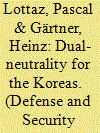

|
|
|
|
|
| Summary/Abstract |
This article builds a novel argument for the unification of the two Korean states by way of a dual neutralisation process. After reviewing the neutralisation concept and the history of neutrality ideas for the peninsula, the authors introduce two historical models that would fit the security needs of both Koreas and their respective security partners. Using a realist framework, it is argued that the “Finlandisation” of the DPRK on the one hand; and the “Austriasation” of the ROK on the other, would not change the de facto security relationships with their patrons, but would create the structural underpinning for future foreign policy compatibility. Assuming other factors remain equal and a solution to internal political division could be brokered, the article proposes a security framework for both states aimed at separately creating the structures for a future unified neutral Korea.
|
|
|
|
|
|
|
|
|
|
|
|
|
|
|
|
| 3 |
ID:
187347
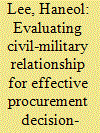

|
|
|
|
|
| Summary/Abstract |
Overseas procurement aims not only to acquire the most high-end weapons systems, but also to enhance their technological expertise. However, the degree to which a procuring state succeeds in these dual objectives varies. Sometimes, a state acquires nearly the most advanced weapon systems in a timely manner with significant terms of technology transfer. At other times, a state’s procurement is fraught with a series of disadvantageous decisions on technology transfer, maintenance, and timeliness. From where does this variation in effectiveness emanate? This article argues that the key to explaining these variations is civil–military co-ordination. States can secure effectiveness when a civilian chief executive proactively capitalises on appointment authority and/or when proactive civil–military consultations transpire. For these causations, this article studies two major fighter jet procurement activities of the Republic of Korea (ROK), the Korea Fighter Project (KFP) and the Fighter eXperimental-I (FX-I) programme.
|
|
|
|
|
|
|
|
|
|
|
|
|
|
|
|
| 4 |
ID:
187350
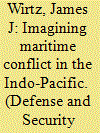

|
|
|
|
|
| Summary/Abstract |
Historical analogies are sometimes used to imagine the scope and nature of a potential conflict in the Indo-Pacific. Using analogies, scenarios, and “images” of future war, instead of strategy, however, can produce an inadequate assessment of future material, operational, and tactical requirements that will be encountered by the U.S. Navy in the maritime domain. Without a long-term strategy to set force development and guide operational requirements, the U.S. Navy will suffer from a “strategy deficit” when it comes to dealing with deterrence, coercion, and escalation in the Indo-Pacific. As planning guidance, the use of analogies is no substitute for strategy.
|
|
|
|
|
|
|
|
|
|
|
|
|
|
|
|
| 5 |
ID:
187349
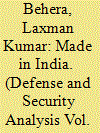

|
|
|
|
|
| Summary/Abstract |
With INR 107.45 billion ($1.54 billion) worth of arms exports and export authorisations in 2018–2019, India realised its biggest annual defence export ambition to date. Breaking into the world’s top 25 defence exporters for the first time, India has set its goal even higher, with a target of INR 300 billion ($5 billion) in defence exports by 2025. Can India achieve the goal and join the ranks of major arms exporting countries? What would it take for India to realise its defence export goal? And what has India done to achieve it? The paper examines India’s recent defence export performance and, in so doing, it probes various reform initiatives taken by the Indian government to promote international arms sales. The article argues that India has a significant domestic arms manufacturing capability, which, if harnessed properly, could propel the country as a significant player in the global arms bazaar.
|
|
|
|
|
|
|
|
|
|
|
|
|
|
|
|
| 6 |
ID:
187345
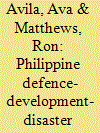

|
|
|
|
|
| Summary/Abstract |
The Philippines suffers from three threats to its national security. Firstly, unlike advanced states, it faces both external and internal assaults on its political and territorial sovereignty. Secondly, self-sustaining economic security remains elusive, with the country failing to emulate the economic successes of its ASEAN neighbours, Singapore and Malaysia. Thirdly, the archipelago must constantly contend with the destabilising effects of natural disasters, including volcanic eruptions, typhoons, and earthquakes. Manila's policy responses to these three disparate, but interlinked threats, have been conditioned by four centuries of Spanish, American, and Japanese occupation. The Philippine government remains a work in progress as diverse efforts to build institutional capacity have produced uneven results. Nevertheless, recent innovative policy approaches are instructive. These are framed around what might be termed a D3 (Defence-Development-Disaster) security paradigm, covering external military security, internal security and non-traditional security, including the Duterte administration's “drug war”
|
|
|
|
|
|
|
|
|
|
|
|
|
|
|
|
| 7 |
ID:
187344
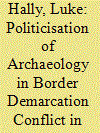

|
|
|
|
|
| Summary/Abstract |
Within contemporary developments of Asian regional security, a core undertone of conflict catalysts and motivations for territorial claims is directly motivated through archaeological findings. These findings include artefacts and settlements, which are utilised to justify political and territorial claims in the region. This overlooked factor will be analysed using three regional case studies through an archaeological and security studies lens. The research aims to further understand Asia Pacific regional security and political disputes and reflect conflict motivation undertones of each interacting nation-state. The article assesses core case studies of Chinese claims in the South China Sea, Japanese and Korean island claims, and Thai-Cambodian temple disputes. The research will analyse how site evidence becomes politicised to justify territorial claims in Asia- Pacific. Through interdisciplinary research, the article will conclude with a greater understanding of assessing conflict development and motivations between state actors in the Asia Pacific region.
|
|
|
|
|
|
|
|
|
|
|
|
|
|
|
|
| 8 |
ID:
187343
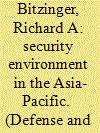

|
|
|
|
|
| Summary/Abstract |
Countries in the Asia-Pacific have many reasons for acquiring new defense hardware and improving national military capabilities. The region is clearly one of constantly shifting security dynamics, with rising great powers, new threats and security challenges, and new military commitments. All of these require new capabilities for power projection, mobility, firepower, intelligence and surveillance, and joint operations, thereby driving regional military modernisation. Consequently, some of the most modern and most advanced armaments are finding their way into the inventories of Asian militaries. Many regional militaries have experienced a significant, if not unprecedented, build-up in terms of both quantity and quality, over the past several years. Recent acquisitions by regional armed forces constitute something more than mere modernisation; rather, the new types of armaments being procured and deployed promise to significantly expand regional maritime and airborne warfighting capabilities.
|
|
|
|
|
|
|
|
|
|
|
|
|
|
|
|
|
|
|
|
|